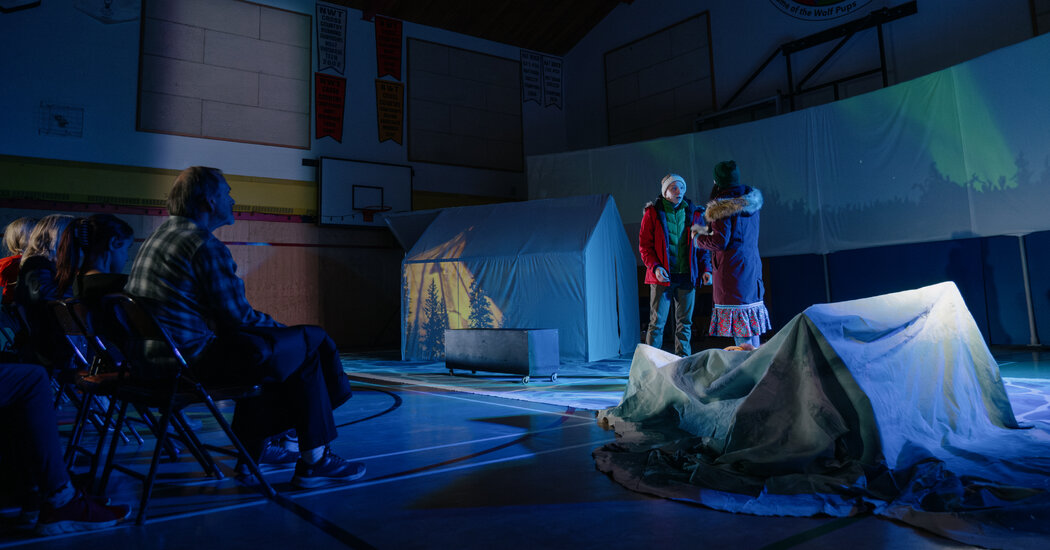The lanky green-pink lights danced wildly across the horizon, pulsating like an incandescent curtain in the breeze.
I thought it was the closest I had been to God since the birth of my children. I cried.
My experience was far from unique. Each year tens of thousands of people flock to Arctic and sub-Arctic destinations seeking that near-religious connection with the aurora borealis, spending about $1.5 billion while doing it.
Canada’s Northwest Territories are a key destination, along with Finland, Norway, Greenland and Iceland.
But Indigenous people in the Far North have been living under the lights for centuries. They have their own lore about the aurora, experiencing it as part of life’s canvas, rather than a once-in-a-lifetime event.
It’s that relationship with the aurora that’s told in “Kiuryaq,” a new play that emerged from a four-year collaboration between Indigenous and non-Indigenous artists from Canada, Greenland and the Sápmi region in Norway.
I watched “Kiuryaq,” which means “northern lights” in the director Reneltta Arluk’s native language of Inuvialuktun, in a school gymnasium of Fort Simpson, a community of about 1,100 in the Northwest Territories.
I sat among an audience of roughly 80 people — quite the turnout given the community’s size — that roared with laughter over jokes that sometimes went over my head, and was enthralled as familiar stories unfolded onstage.
Three Indigenous actors — one from Canada, one from Greenland and one from Norway — play a number of characters and much of “Kiuryaq” is set against original music composed by the Canadian musician Carmen Braden.
Video of the aurora and other scene-setting images are projected on the simple but effective set of a white canvas tent and a large concave screen, giving the play an immersive feel. The economic setup means that the performance can travel far, with some modifications.
To play at Fort Simpson, for example, the cast and crew drove more than seven hours from Yellowknife, the capital of the Northwest Territories, but did not bring the large screen over the bumpy roads. Instead, a projector beamed the videos on a makeshift screen made of stretched white bedsheets borrowed from a nearby inn. It worked perfectly.
“Kiuryaq” has been touring the Canadian North and will travel to Nuuk in Greenland this month. It will be performed on a larger stage early next year at Vancouver’s Push Festival and go to Norway in 2027.
The goal is to reach northern audiences as well as to bring outsiders to the tales of the northern lights by those who know them best, Ms. Arluk, who was also one of the play’s writers, told me.
“What people from the North see in this play is that they are not watching an interpretation of themselves,” she said. “They see themselves.”
In the words spoken by one of the characters, Marie, played by Julia Ulayok Davis:
“The first time I saw Kiuryaq…
I can’t recall because I’ve always lived under them.”
The play comes at an important moment for Arctic communities to assert their sovereignty. As the region becomes a new stage for global power competition — President Trump wants to buy Greenland and take over Canada, and Chinese and Russian militaries wander the Arctic Ocean — Arctic artists are reminding anyone paying attention that this is their ancestral land.
The plot of “Kiuryaq” revolves around a girl, Marie, being raised by her grandparents in the Canadian Arctic. She goes trapping with her grandfather and rides Ski-doos in what seems an idyllic northern upbringing, but there is pain there.
Her mother is absent, and soon we learn there was a baby brother, Rowan, played by the Greenlander Salik Lennert, given up for adoption. The northern lights are the play’s fourth actor: Marie talks to them, dances underneath them and, some times, challenges them.
Marie’s grandmother, retelling tales she grew up with, warns her against provoking the lights, calling on them or, god forbid, whistling at them. Marie does not heed her warnings and, for a brief moment, the lights steal her away, leading to a song Marie performs a few times throughout the play:
“There was a girl who reached for the moon
And whistled at Kiuryaq
Her little hands grasped upwards
as she jumped and whistled
She was lifted up, could see past the moon,
past the clouds, through the lights,
into the night.”
It is through the sharing of this ancient tale, that if you whistle at the northern lights they’ll take you, that “Kiuryaq” came to be.
Ms. Arluk had heard this as a child growing up in Inuvik, an Arctic town in Canada, and asked Rawdna Carita Eira, the Sami co-creator of the play, if she too had heard this in Norway’s Sámpi region, where she hails from. She had. They discovered that this legend was shared, with variations, by several Indigenous communities as part of the lights’ lore passed down through generations.
The plot then shifts to the adopted younger brother, who has been raised far from his community in London, Ontario, but yearns to know his past and feels a calling to the lights, and to the north.
The story builds until the two siblings reunite under the aurora.
Adoption is one of several painful themes that “Kiuryaq” tackles, offering an education to outsiders and recognition to insiders.
In Canada, thousands of Indigenous children were systematically adopted out of their communities in the 1960s, a practice that came to be known as “the scoop.” While some found loving homes, others suffered immensely either because of exploitation and abuse, or because they felt a foundational disconnect and yearned for their communities.
The play unfolds in different parts of Canada and follows a few story lines alongside the main one about the two siblings.
It pokes fun at the commodification of the northern lights, and of being Indigenous in pursuit of an income in the aurora tourism industry.
The audience in Fort Simpson laughed hysterically at the character of Frank, played by Elin Oskal, an Indigenous aurora tour operator who is exhaustingly enthusiastic about the lights, and very cringe about marketing his own Indigenous identity as part of his business.
This is comedic territory non-Indigenous writers and artists would not necessarily tread, for good reason: The inside jokes are usually best left to the insiders to tell.
“Kiuryaq” was at its most captivating when it directly tackled the tension between Indigenous Arctic life and philosophy, and Western culture.
Marie’s monologues are vehicles for commentary on that tension. “Move on and live the future instead of the past,” she says about the advice she gets to let go of her traditions. “So colonial,” she adds.
And she sings powerfully about the importance of connecting the past to the future, using a traditional Indigenous face marking, a line on the chin, as a metaphor.
“This line on my face is a connection to my ancestors.
I got it to keep, knowing myself.
They tried to erase our history kept on our skin.
Break the line we have within.
Not anymore.
This line existed before Christian arrival.
Nanaak, I have not forgotten why we do not whistle at kiuryaq.
My dreams still remember some of Tataak songs and stories.
My children, if I have them, will drum and I will dance for them.
Like the lights dance for me.
This line connects us into our future.”
Matina Stevis-Gridneff is the Canada bureau chief for The Times, leading coverage of the country.
The post Theater About the Northern Lights, by Those Who Know Them Best appeared first on New York Times.




